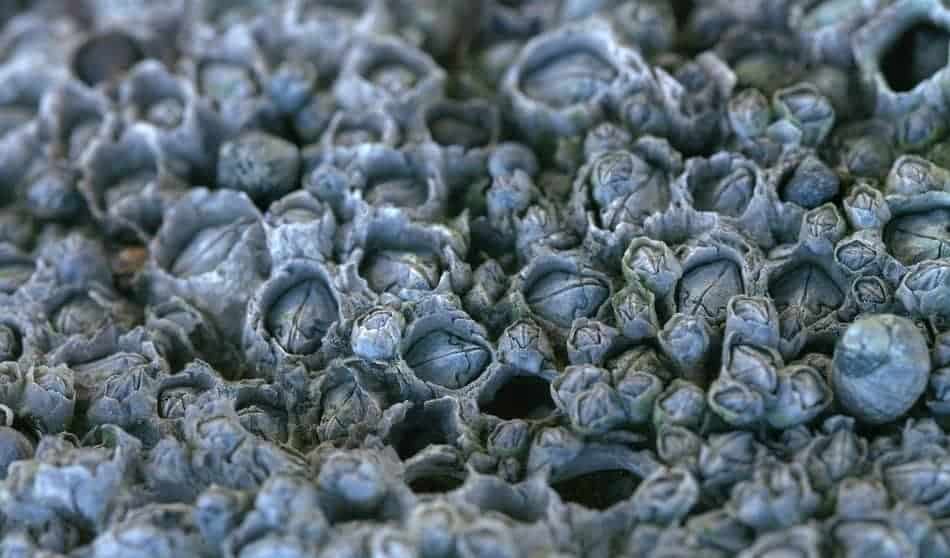
You might have seen these small creatures (critters) on the boat’s hull and wondering what they are? and do they do anything bad to the boat? Why they attach themselves to the boat? Okay, first, let’s see what are barnacles on the boats in a detailed way and then their effects and precautions.
Barnacles are marine growth similar to small living creatures (critters) such as small-sized lobsters and shrimps, and you may see them on a boat hull kept in the water for a long time. They secrete a liquid glue, which later turns into a strong cement-like substance and sticks on to the boat hull.
Barnacles are common among the boats that are kept in the water for a long time. And for the most part, you may not see them in freshwater because barnacles are mostly marine creatures and live in salt and brackish water only. Even in freshwater, you may see barnacles but, chances are less.
Generally, these barnacles tend to stick or get themselves attached to firm (solid and strong) surfaces such as boats, piers, whales, rocks, turtles, etc. because these surfaces are clean, keep them clean, and adhere (easy to stick to these surfaces quickly) compared to mud at the bottom or plants. So, it has nothing to do particularly with attaching themselves only to the boats.
Once they find a place to stay, like boat hulls or rocks or any, they will clean that attaching surface by releasing fat and then secrete a liquid glue to fully stick onto that surface (source). If it finds a firm surface, it attaches to that, so, for the most part, it has nothing to do with sticking only to the boat’s hull.
DO YOU KNOW? Barnacle glue is six times stronger than any humanmade glue. Several scientific studies are currently attempting to reproduce barnacle glue and explore its use in the fields of engineering, construction, and medicine, where it can be used as a biological sealant during or post-surgery.
PROPSPEED
So, you can expect the uninvited guest on the objects that are in the water for a long time, such as boats, piers, whales, turtles, rocks, etc. And mostly, the survival chances of barnacles in fewer moisture areas are low. They require moisture to stick to the boat and grow; if there is less or no moisture, they will perish slowly.
Check this small video on extreme barnacles blasting and removal, and that’s what happens to a boat if it is kept in the water for a long time without any proper inspection and maintenance down the line.
Effects of barnacles on boats
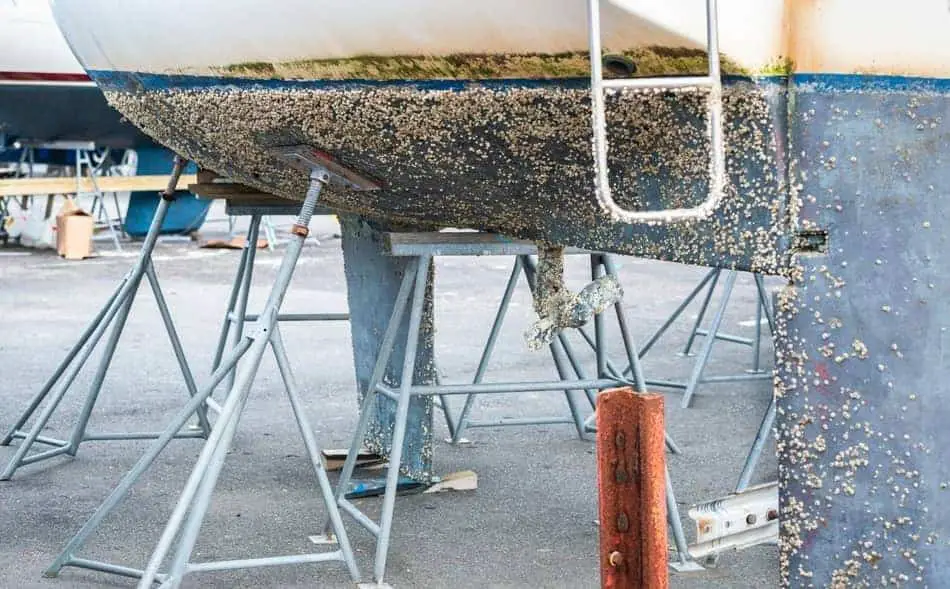
If they were no effects of barnacles on boats, probably many people would have ignored them. But in reality, there are many adverse effects of barnacles on boats. We will now see what are the effects of barnacles on boats in a detailed way.
The main impact of not removing barnacles on the boat is that they reduce the boat speed due to increased drag and eventually increases fuel consumption, which is proportional to money. So, they take your money and time if you didn’t look after them at the early stages of their growth.
1. Barnacles reduces the boat speed
- The major drawback of having barnacles attached to the boat’s hull is they reduce the boat speed a little. On the boat hull, Barnacles will make the water not to slide over them smoothly, increasing the friction resistance between water and hull and reducing the boat speed.
- If the boat hull is smooth, water will slide over the hull smoothly. Otherwise, it causes some disturbance and gradually decreases the speed of the boat. Anything attached or stuck to the hull, such as barnacles, depth sensor, keel, etc. will decrease the boat speed, not only barnacles.
2. Barnacles increase the fuel consumption of the boat
- Another major drawback of having barnacles on the boat hull is they increase fuel consumption because they make the hull’s surface rougher, which increases drag on the hull, requiring more power from the engine to maintain speed, meaning burning more fuel that finally costs money.
- For example, traveling from New York to Rotterdam, at 12 knots is 11d 18hrs, assume a loss of 1 knot due to barnacle drag, then that trip takes 12d 20hrs. At the cost of 433 dollars per MT (metric ton), using approximately 20 MT per day, it will cost an additional 9,400.00 dollars a day (source).
3. Barnacles damages the hull surface
- Although barnacles themselves won’t damage the boat hull, as they get larger (leaving them for a long time), their bases can get through all the paint and down to the bare metal, and once the steel is exposed to the water, the water corrodes the metal and damages the hull over time.
- Barnacles can destroy the wooden boats most compared to fiberglass hulled boats or metal hulled boats because removing (peeling off) barnacles from a wooden hull with any tools can sometimes result in wood wearing off. On the other hand, nothing happens to the metal or fiberglass hulled boats.
4. Barnacles may cause disturbances to water intake units
- Boat and boat engines generally take water (Raw water is a normal water a boat draws from the surrounding water, so seawater in most cases unless it is operating in freshwater) for many purposes. And generally, these waters are used for cooling down the engine most commonly.
- Barnacles often sticking or attaching themselves to that water intake inlets can restrict the flow of the water, which can lead to engine overheating and affect other systems that rely on that water flow as well. Which eventually takes more money to get it repaired or replaced.
5. Barnacles disrupts propeller’s smooth motion
- Barnacles create disturbances in the water flow over the propeller. A propeller is a highly engineered piece of equipment designed to smoothly cut through the water and propel the vessel it is attached to. Barnacles that have attached themselves to the surface of the propeller cause irregularities in the water flow over the propeller
- That irregularities in the water flow over the propeller cause the engine to work harder to turn it and potentially damage the shaft and bearings attached to the propeller. Even if the hull is covered in growth, you should make every effort possible to remove barnacles from the vessel’s propeller first before using the boat to reduce damages to the engine.
6. Barnacles can destroy the appearance of the boat
- Barnacles ruin the appearance of the boat. Everyone sees your wonderful boat and may praise you for that, but after looking below the bottom line may totally change their mind because you have barnacles attached to the boat, and you have forgotten to clean them up.
- This won’t be a problem for the people who keep their boats in the water most of the time because most people will see the boat above the waterline than below the bottom line (mostly). Since the appearance is involved here, your boat resembles a normal (good) look.
Finally, those are some of the major effects of barnacles on boats. The main problem of not removing barnacles on the boat is that they reduce the boat speed due to increased drag and eventually increases fuel consumption, which is proportional to money. So, better be treating them prior to their early stages to avoid any major problems in the future.
How to prevent barnacles on boats?
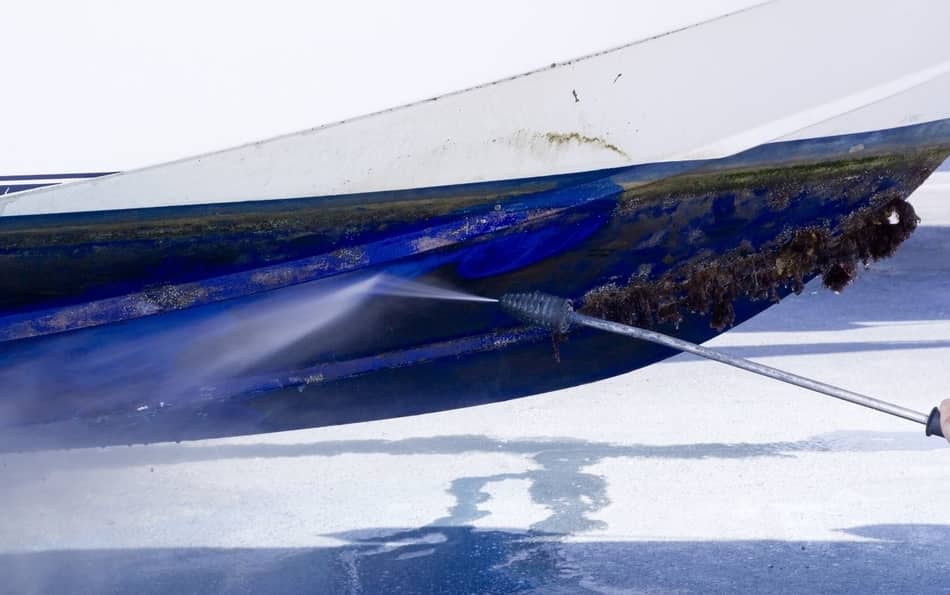
After knowing all those adverse effects of barnacles on boats, anyone may think that prevention is better than cure. We will now see how to prevent and remove barnacles on boats in a detailed way.
Generally, while treating barnacles, if the boat is always kept in the water most of the time, it needs to be treated differently from a boat that is oftentimes taken out of the water. We will now see how to deal with barnacles on the boats that are kept in the water for a long time and the boats that are not kept in the water for a long time separately.
For the boats kept in the water all the time (most of the time)
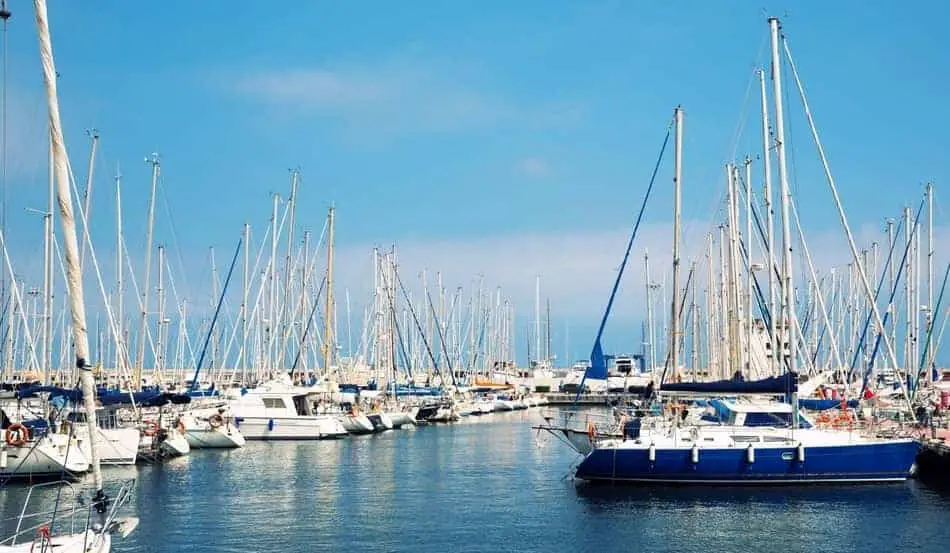
Barnacles most likely attack the boats that are kept in the water for a long time than shorter times because they need moisture to survive; if there is less moisture, the survival chances are low. So, boats that are in the water for longer times are more susceptible to getting attacked by barnacles.
The glue starts to work on the surfaces if there is moisture; otherwise, the glue won’t stick to the surface hard enough. So, if you are keeping your boat most of the time in the water, you need to take some precautions prior to avoid barnacles on your boat to some extent.
1. Use anti-fouling paints to prevent barnacles
Using anti-fouling paint is one of the highly recommended solutions to prevent barnacles from attaching to boats. Anti-fouling paint (aka bottom paint) contains chemicals (biocide and copper) in it, and it starts slowly releasing the copper overtime to stop the barnacles and other growths as well.
That doesn’t mean that just using anti-fouling paint will prevent the barnacles from completely attaching to the boat, only to some extent. Barnacles can start growing on the boat slowly, and when the copper leaches out completely of the bottom paint, it grows more. (So, a regular inspection and maintenance are required oftentimes to prevent them completely).
Since the boat is kept in the water most of the time, anti-fouling paint often needs to be replaced. How often it needs to be replaced depends on your area’s growth and the type of paint you choose but expect to have your boat’s bottom repainted every 2 to 5 years (sometimes even less).
Generally, the barnacle’s growth depends on water type (saltwater or freshwater, or brackish water). If you sooner saw more growth on the boat’s hull (in a less period of time), then replacing the paint quite often for a year or two or less is essential.
The downside of using anti-fouling paints on boats is that it harms aquatic life because this paint releases the copper over time and that copper may affect the water’s aquatic life. However, one boat alone can’t hurt the aquatic life, but a marina with 100s of boats or more can.
Related post – Check my article on Why do boats need bottom paint to know some of the benefits and drawbacks of using anti-fouling paint on boats in a detailed way with examples.
2. Clean the hull manually (hire a hull cleaner) to remove barnacles
Cleaning the hull (pressure washing) and then scrubbing with a paint scrubber or any is the only best solution to remove barnacles out of the boat’s hull completely. If you aren’t able to do that by yourself, you can hire a hull cleaner (diver) to do that.
But cleaning and scrubbing the boat hull with a paint scrubber can peel out the bottom paint as well (if you have bottom paint), which can result in exposing the gel coat to the water, which eventually results in causing blistering and algae growth as well since the bottom paint is not there.
To prevent peeling off the bottom paint while scrubbing the boat hull, either you need to do it carefully, or you can use hard bottom paint, such as applying the anti-fouling paint with a mixture of epoxy resin and a high percentile (99.99) of copper powder with it.
That is tough paint, and even if you scrub the hull with the scrubber, the paint will not be peeled out easily or quickly. So, it is better to use hard paint once, instead of applying the bottom paint, again and again, every time after scrubbing the boat hull.
Finally, anti-fouling paint will only just prevent barnacles to some extent, not completely. So, regular inspection and maintenance are required oftentimes to prevent completely. If you saw anything on the hull, cleaning it earlier will be the best step to prevent any future damage.
For the boats that are not kept in the water most of the time
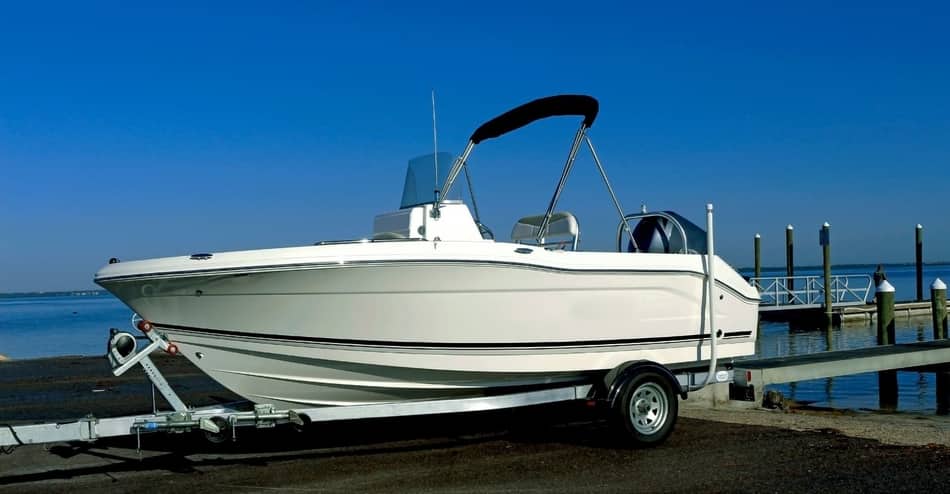
Barnacles most likely won’t attack the boats that are off the water most of the time because they need moisture to survive; if there is less moisture, the survival chances are low. So, boats that are in the water for shorter periods are less susceptible to getting attacked by barnacles.
That is because barnacles releases glue to stick to the hull; for that glue to stick well, it requires moisture (water), and if the moisture is limited, barnacles attaching to the boat will be less. So, dry storing the boat is a good solution to prevent barnacles. But, if you often (daily) go boating, barnacles can attack your boat.
1. Cleaning the hull regularly is the best solution to remove barnacles
For boats that are not kept in the water for a long time, a routine cleaning (pressure washing) of the hull is sufficient and anti-fouling paint is also not required because dry storing the boat will stop (slow down) the barnacle’s growth and reduces the process of attaching to the hull.
If you have a small boat, storing the boat at home on a trailer or dry storing or blocking the boat is a good solution to prevent the barnacle’s growth on the hull. And whenever you go boating, cleaning the boat after every ride for 10 minutes or so will definitely stop the barnacle’s growth on the hull.
And generally, anti-fouling paints are not required for the boats that go very few times for boating (once or twice a week); pressure wash is sufficient to prevent any growth. Anti-fouling paint is highly recommended for the boats that often go boating (4 or 5 or more timer per week) or for the boats that stay in the water all the time.
Overall, a proper inspection, pressure washing, and scrubbing of the boat hull is the only best solution to remove the boat’s barnacles. Anti-fouling paints can be used to prevent barnacles to some extent for the boats that are kept in the water for a long time, and bottom paint is not required for the boats that are not kept in the water most of the time.
Related post – Check my article on Growth prevention tips on boats to know the other effects of keeping a boat for a long time in the water, such as algae and blistering, in a detailed way.
The takeaway
Barnacles are tiny living creatures (critters) in the water, comparable to very small-sized lobsters and shrimps. They tend to attack (stick or attach to) firm and solid surfaces such as boats, piers, whales, rocks, turtles, etc. So, it has nothing to do only with the boats; they attach to firm surfaces.
The firm surfaces like boats, rocks, whales, etc. will be clean and makes the barnacles clean, so they tend to attach towards firm surfaces rather than delicates surfaces like mud at the bottom of the sea or plants or any small creatures.
The main effect of not removing barnacles on the boat is that they reduce the boat speed due to increased drag and eventually increases fuel consumption, which is proportional to money. So, they take your money and time if you didn’t look after them at the early stages of their growth.
